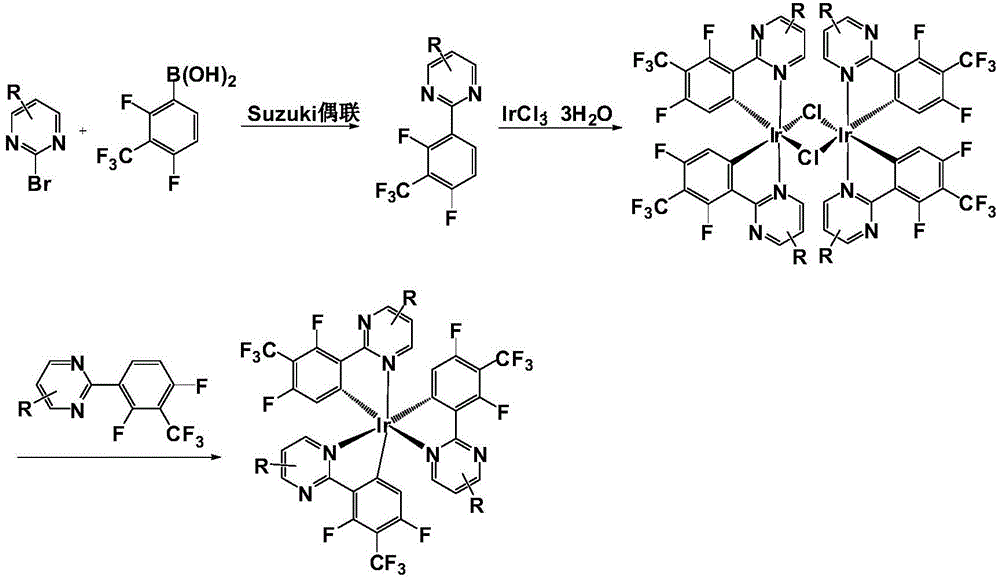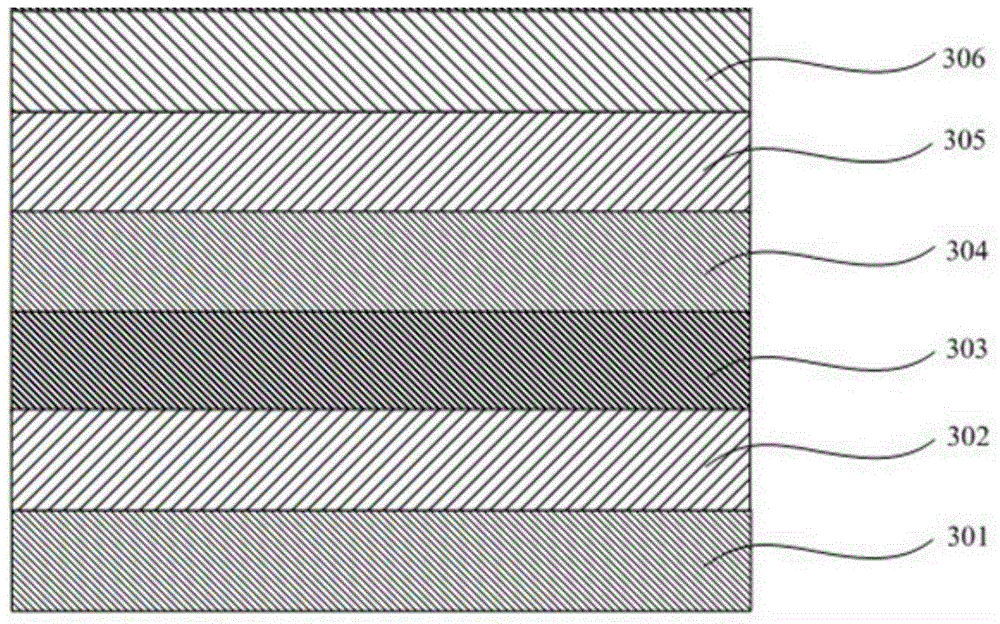Organic blue light electrophosphorescent material, preparation method thereof and organic electroluminescent device
A phosphorescent material, electromechanical technology, applied in luminescent materials, electro-solid devices, organic chemistry, etc., can solve problems such as poor blue color purity, and achieve the effects of reducing self-quenching, mild reaction conditions, and improved luminescence performance
- Summary
- Abstract
- Description
- Claims
- Application Information
AI Technical Summary
Problems solved by technology
Method used
Image
Examples
preparation example Construction
[0044] figure 1 It is a schematic diagram of the preparation process of the blue light organic electrophosphorescent material in each embodiment; please refer to figure 1 , the preparation method of the above-mentioned blue light organic electrophosphorescent material, comprising the following steps:
[0045] (1) Under the protection of inert gas, the structural formula is A: The compound A and the structural formula are B: Compound B is dissolved in the first organic solvent containing catalyst and alkali to obtain a reaction solution, and the reaction solution is subjected to a Suzuki coupling reaction. After the reaction is stopped, the reaction solution is separated and purified to obtain a structural formula of C: ring metal ligand; wherein, the molar ratio of compound A to compound B is 1:1.1 to 1:1.5; the coupling reaction time is 6 to 12 hours, and the reaction temperature is 85 to 100°C; wherein, R is a hydrogen atom or C 1 ~C 20 straight or branched chain alky...
Embodiment 1
[0078] Example 1: Complex tris(2-(4',6'-difluoro-5'-trifluoromethylphenyl)pyrimidine-N,C 2 ') Synthesis of iridium
[0079] (1) Synthesis of 2-(2',4'-difluoro-3'-trifluoromethylphenyl)pyrimidine
[0080]
[0081]Under nitrogen protection, 1.59g (10mmol) 2-bromopyrimidine, 2.71g (12mmol) 2,4-difluoro-3-trifluoromethylphenylboronic acid and 0.58g (0.5mmol) tetrakis (triphenylphosphine) palladium Dissolve in 40mL toluene and stir for 10min. Subsequently, 20 mL of an aqueous solution containing 2.76 g (20 mmol) of potassium carbonate was added dropwise to the reaction system. Heated and stirred at 100°C for 6h. After the reaction solution was cooled to room temperature, it was extracted with dichloromethane, separated, washed with water until neutral, and dried over anhydrous magnesium sulfate. After filtration, the filtrate was distilled off the solvent under reduced pressure to obtain the crude product. Silica gel column chromatography was performed with ethyl acetate an...
Embodiment 2
[0102] Example 2: Complex tris(2-(4',6'-difluoro-5'-trifluoromethylphenyl)-5-methylpyrimidine-N,C 2 ') Synthesis of iridium
[0103] (1) Synthesis of 2-(2',4'-difluoro-3'-trifluoromethylphenyl)-5-methylpyrimidine
[0104]
[0105] Under nitrogen protection, 1.73g (10mmol) 2-bromo-5-methylpyrimidine, 2.48g (11mmol) 2,4-difluoro-3-trifluoromethylbenzeneboronic acid and 0.28g (0.4mmol) dichlorobis( Triphenylphosphine) palladium was dissolved in 50mL DMF, and stirred for 10min. Subsequently, 25 mL of an aqueous solution containing 3.18 g (30 mmol) of sodium carbonate was added dropwise to the reaction system. Stir the reaction under heating to 90°C for 8 hours. After the reaction solution was cooled to room temperature, it was extracted with dichloromethane, separated, washed with water until neutral, and dried over anhydrous magnesium sulfate. After filtration, the filtrate was distilled off the solvent under reduced pressure to obtain the crude product. Silica gel column...
PUM
 Login to View More
Login to View More Abstract
Description
Claims
Application Information
 Login to View More
Login to View More - R&D
- Intellectual Property
- Life Sciences
- Materials
- Tech Scout
- Unparalleled Data Quality
- Higher Quality Content
- 60% Fewer Hallucinations
Browse by: Latest US Patents, China's latest patents, Technical Efficacy Thesaurus, Application Domain, Technology Topic, Popular Technical Reports.
© 2025 PatSnap. All rights reserved.Legal|Privacy policy|Modern Slavery Act Transparency Statement|Sitemap|About US| Contact US: help@patsnap.com



